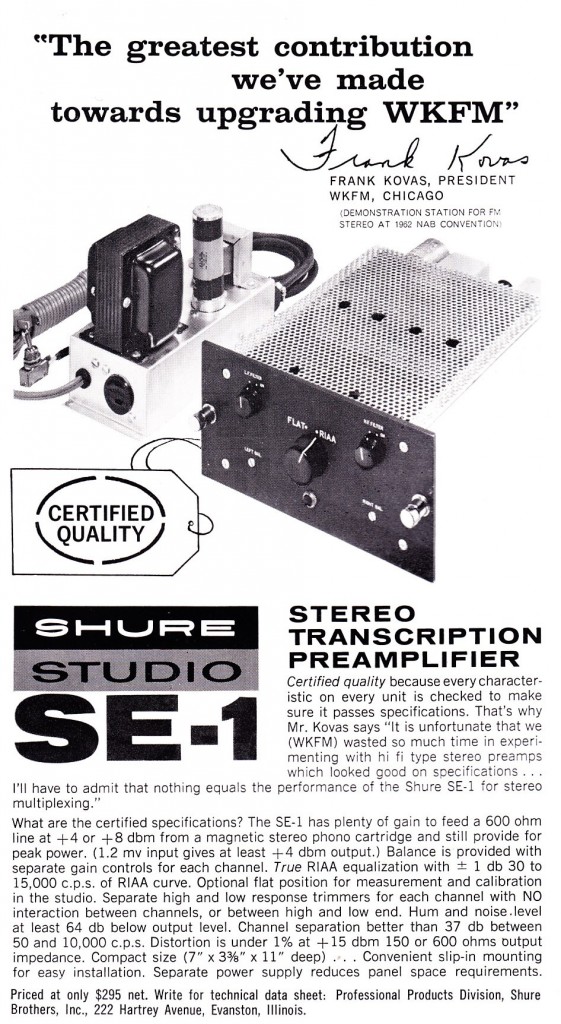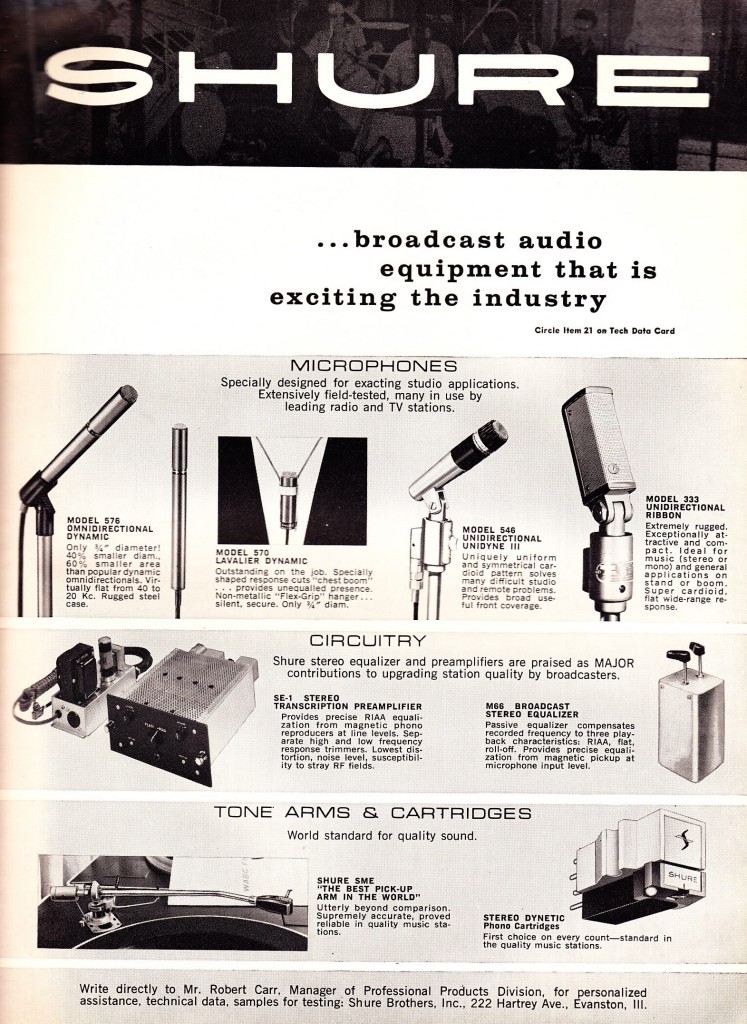 Above, Shure’s SE-1 RIAA phono pre. I would love to see the schematic for this is anyone can direct me to it. The specs look extremely good. These seem to go for a pretty penny on eBay and seems like a worthwhile thing to DIY. Anyone?
Above, Shure’s SE-1 RIAA phono pre. I would love to see the schematic for this is anyone can direct me to it. The specs look extremely good. These seem to go for a pretty penny on eBay and seems like a worthwhile thing to DIY. Anyone? And above, again, this time next to Shure’s 576, 570, 546 (AKA SM-56) and 333 mics. I have the ‘other’ broadcast – quality Shure Ribbon, the 300, and I like it alright… had it re-ribboned by Stephen Sank and it’s decent. The 300 definitely sounds v v vintage but it’s a useable sound. Really want a 333. This is the same as an SM-33, yes? No? anyone using these things lately?
And above, again, this time next to Shure’s 576, 570, 546 (AKA SM-56) and 333 mics. I have the ‘other’ broadcast – quality Shure Ribbon, the 300, and I like it alright… had it re-ribboned by Stephen Sank and it’s decent. The 300 definitely sounds v v vintage but it’s a useable sound. Really want a 333. This is the same as an SM-33, yes? No? anyone using these things lately?
Categories
8 replies on “Shure SE-1 RIAA phono pre-amp circa 1964”
Hey Chris:
Shure SE-1 info right here:
http://cdn.shure.com/user_guide/upload/1455/us_pro_se1_ug_27a303.pdf
If I were doing a modern version, I’d probably have RIAA, flat (no EQ) and then a variable turnover/rolloff, maybe with several plug-in filters like the Pultec broadcast phono preamp. Since the Shure has the vertical/lateral controls, it would be useful for 78s, and thus you need some turnover and rolloff options. You can look at the TDL Restoration Preamp for some EQ circuit ideas.
The Shure preamp was designed to work with a relatively high output moving magnet cartridge like the Shure pictured in the brochure, which was a direct ancestor of the still-made Shure M44 series.
The other interesting thing the Shure literature is the passive phono equalizer that allegedly produces mic-level output. Must be ribbon mic level, because a passive RIAA network has a bit of insertion loss. If you had something like a Pultec MB-1 on the other end of the network, you’d do fine. In modern terms, you’d want one of that newer kind of mic preamp designed for ribbon mics (providing a clean 60-80dB of gain rather than 40dB like most vintage mic preamps).
— Tom Fine
These are a repackaged Dyna PAS, minus all the switching and with addition of a transformer coupled pro balanced output. Therefore DIY would be, if not trivial, pretty simple. They actually bought the boards from Dynaco.
For home listening you probably do not want +4 balanced 600 ohm output. You could simply not use that and go directly out but you run into the PAS’s main fault then. It has a very high output impedance, which is no liability when driving a Dynaco tube amp, if the cables are short, but otherwise isn’t so good.
Interesting. I had noticed the dynaco logo on the pcn in a photo and i was wondering about that. Ive had the pas schem for
Years now, never tried it, i guess this is the time to! Re outpt, i imagine i will just add another twin triode split as cathode followers.
If you are doing 78s look t Gary Galo’s modified McIntosh C8 preamp.
One man’s opinion, I think the best tube phono preamps, by far, were the McIntosh C8 and the Marantz 7. Copy the designs of those phono stages, use modern low-noise high-precision passives and a robust modern power supply and you can’t go wrong for a RIAA phono preamp.
This website is interesting, but some of it could be audiophoolery:
http://www.high-endaudio.com/RC-PhonoStages.html
Note the Lipschitz RIAA network stuff, that may supercede any of the older circuits as far as accuracy goes.
— Tom Fine
I agree with the caveat the C8 is a mono pre and has a lot of pre-RIAA curves built in so that it is not a suitable stereo pre. They are often sold in pairs on eBay and the stupids buy them at inflated prices that way.
The McIntosh C22 is an electronic clone of the Marantz 7 with a different layout and controls of course. There was a Japanese guy who built two different homebrew C22 clones and put up nice pictures on the internet, which are now gone. Marantz used higher grade parts than did Mc. The Marantz was reissued in a version OEMed by VAC of Florida and it appears from commentary on various forums a Chinese company is selling a clone under the “Sid Smith” name. Maybe they found a “Sid Smith” and hired him.
Bare or stuffed boards to build your own Marantz 7 clone are always available on eBay as well.
What would be great would be a Marantz 7 phono preamp clone that also had the bass and treble EQ switches following the phono stage. They would definitely get you away from strict RIAA compliance but, let’s face it, many LPs don’t sound so great without a little EQ tweaking. It would be very helpful for a podcast compilation producer or the mix-tape maker or the reissuer of obscure platters. Of course, if you’re working pro-grade anyway, you just get a really good, quiet phono preamp and then chain a really good EQ after it. It could be as simple as a Dangerous BAX or as complex as something like the Great River Mastering EQ.
I work with 78’s a lot and I’ll say that, for my personal use and taste, I almost always like to do some EQ after the preamp, even though I have a many-curve preamp. There are a lot of subtle things that can be done to raise the music level and lower the disk noise level, and to assure or restore tonal balance in the music.
With LPs, it’s more often than not undoing bad EQ decisions made either in recording or disk-cutting. Pop and rock tunes were cut to be played on radio, so in many cases the mid-midrange is super-hyped and bass and treble aren’t strong. In other cases, some other frequency band is out of whack. There’s also often baked in hum from the original cutting chain, especially for records cut in the tube era. This is of course not true with the best examples of LP cutting, but remember that LP was the _mass_ medium back then, so it’s often lowest common denominator as far as sound quality!
— Tom Fine
How much bass and treble boost and cut do you want and how do you want it configured? It’s doable.